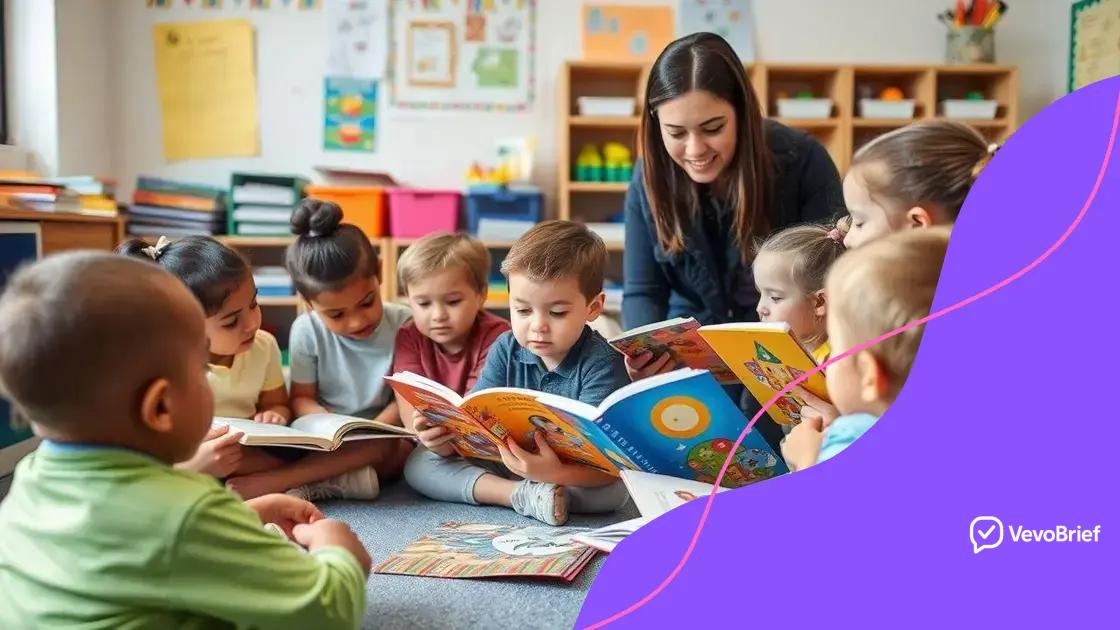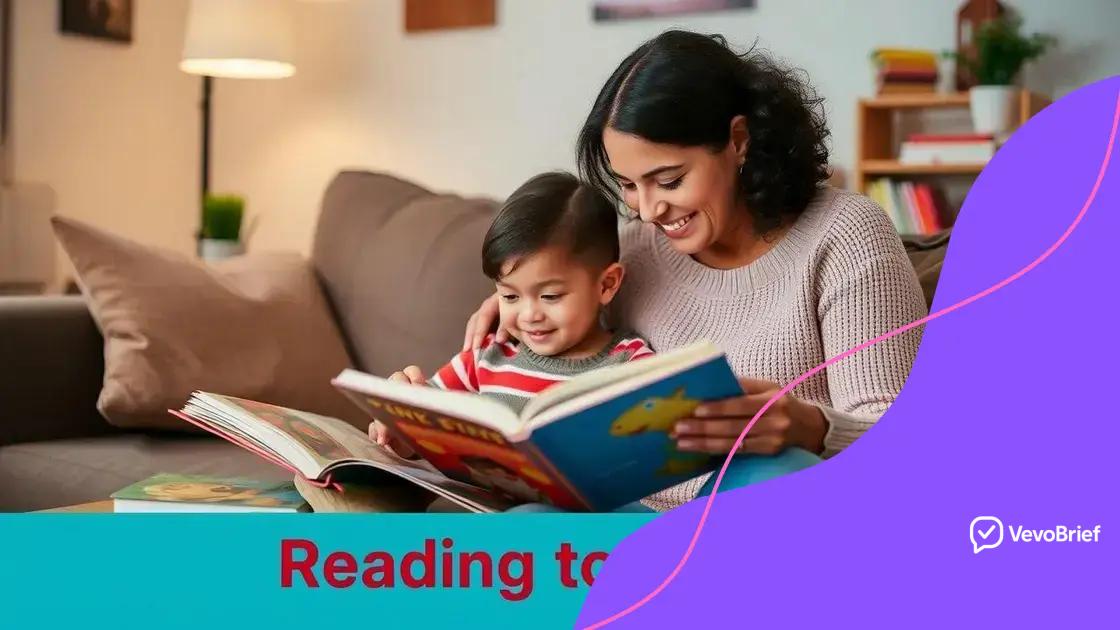Early literacy program evaluation: unlocking potential

Early literacy program evaluation focuses on assessing the effectiveness of initiatives aimed at improving children’s reading skills through targeted metrics and successful community engagement strategies.
Early literacy program evaluation is essential for understanding how well these initiatives support children’s reading development. Have you ever wondered what really makes a difference in early education? In this article, we’ll delve into the key aspects of evaluating these vital programs.
Understanding the importance of early literacy programs
Understanding the importance of early literacy programs is crucial for shaping a child’s future. These programs lay a strong foundation for reading and writing skills, crucial for academic success.
Why Early Literacy Matters
Early literacy skills can predict later academic performance. Children who read proficiently by third grade are more likely to succeed in school and beyond. Furthermore, early literacy initiatives promote cognitive development, encourage curiosity, and foster a love for reading.
Key Benefits of Early Literacy Programs
- Enhances vocabulary acquisition and comprehension skills.
- Builds self-esteem and confidence in young readers.
- Encourages parental involvement in education.
- Supports social and emotional growth through collaborative activities.
Programs designed for infancy and preschool age are impactful. By exposing children to books, storytelling, and interactive reading, these initiatives harness critical developmental stages. Moreover, they can be tailored to meet diverse learning needs and styles.
Research shows that effective early literacy programs use a combination of direct instruction and play-based learning. This approach not only keeps children engaged but also allows them to absorb lessons in a fun environment.
Community Involvement
Engaging local communities is vital. Libraries, schools, and community centers often collaborate to provide resources, workshops, and events focused on literacy. As a result, families gain access to essential tools that support their child’s reading journey.
Involving community members and local leaders helps spread awareness about the significance of these programs. Together, they can advocate for policies that prioritize early literacy and funding for necessary resources.
Key metrics for evaluating literacy programs
Key metrics for evaluating literacy programs help determine how effective the initiatives are. By using specific measures, we can assess the impact these programs have on children’s literacy development.
Common Evaluation Metrics
Metrics should be both qualitative and quantitative. They provide a clearer picture of progress and areas needing improvement. Some of the standard metrics include:
- Reading Scores: Standardized tests can measure reading comprehension and fluency.
- Attendance Rates: High attendance indicates engagement in literacy activities.
- Parent Feedback: Surveys can gather insights from parents about their children’s interests and literacy habits.
- Progress Monitoring: Regular assessments can help track improvements over time.
Another critical element is longitudinal data, as it tracks a child’s literacy journey over several years. This data can reveal trends in performance and the long-term effects of early literacy intervention.
Demographic Considerations
When evaluating literacy programs, it is essential to consider the demographics of the participants. Programs should adapt to the specific needs of diverse communities. Factors such as socioeconomic status, language background, and cultural differences can significantly influence learning outcomes.
By addressing these factors, literacy programs can implement targeted strategies to support all learners. This personalized approach increases the likelihood of success for children facing various challenges.
Ultimately, an effective evaluation process not only focuses on the achievements of individual participants but also examines the program’s overall effectiveness in promoting literacy at the community level. With the right metrics, stakeholders can make informed decisions to enhance and expand successful initiatives.
Effective strategies for early literacy improvement

Effective strategies for early literacy improvement can significantly impact children’s reading abilities. By implementing targeted approaches, educators and parents can foster a love for reading and enhance essential skills.
Interactive Reading Techniques
One effective method is to use interactive reading techniques. This involves asking questions during the reading process, encouraging children to predict outcomes and make connections with the story. For example, while reading, you might ask, “What do you think will happen next?” or “Have you ever felt like this character?”
- Use of Picture Books: Choose engaging picture books that spark interest.
- Shared Reading: Read together with children so they can interact with the text and illustrations.
- Storytelling: Encourage children to tell their own stories, enhancing their narrative skills.
These methods not only build comprehension skills but also promote a positive reading experience.
Integrating Technology
In today’s digital age, using technology can also boost early literacy. There are countless apps and tools designed to make reading fun and engaging. For instance, e-books can include interactive elements that keep children interested.
However, it’s important to balance technology with traditional reading methods. A mix of both can provide children with varied learning experiences, keeping them motivated.
Additionally, phonics-based programs can be highly effective in teaching essential decoding skills. These programs help children understand the relationship between letters and sounds, forming a solid foundation for reading. Training children to break down words into manageable parts makes reading less daunting and more enjoyable.
Parental Involvement
Encouraging parental involvement is vital. Parents play a key role in their child’s literacy journey. Simple activities like reading at home or visiting libraries can make a big difference.
Creating a routine that includes reading time elevates the status of books in a child’s life. When parents show enthusiasm for reading, children are more likely to adopt a similar attitude. This shared experience can lead to greater academic success and lifelong habits.
Challenges in assessing literacy programs
Challenges in assessing literacy programs can hinder our understanding of their effectiveness. While evaluating literacy initiatives is crucial, various factors complicate this process.
Variability in Assessment Tools
One challenge is the variability in assessment tools used across different programs. Various metrics can lead to inconsistent results. For example, some programs may rely on standardized tests, while others might use informal observations. This discrepancy can make it difficult to compare outcomes effectively.
- Standardized Testing: Often focuses on specific skills, potentially overlooking holistic literacy development.
- Informal Assessments: These can be subjective, depending on the evaluator’s perspective and bias.
- Frequency of Testing: Over-testing can lead to stress for both children and educators, impacting performance.
Programs must find a balance between formal and informal assessments to gain a well-rounded view of success.
Socioeconomic Factors
Another hurdle is the influence of socioeconomic factors on literacy success. Children from low-income families may have access to fewer resources, such as books and educational support, hindering their progress.
Programs must address these disparities to ensure fair assessments. Tailoring initiatives to meet the needs of various communities can significantly impact overall success.
Time Constraints
Time constraints also pose a challenge. Educators often have limited time for instruction, making it difficult to implement extensive assessments. The need for fast results can compromise the depth of evaluation, leading to superficial judgments of a program’s effectiveness.
To overcome this, schools and programs must prioritize meaningful evaluations that provide insights into long-term success. Building a culture of continuous improvement can help educators refine strategies based on assessment outcomes.
Addressing these challenges effectively can lead to better insights and improvements within literacy programs. Continuous dialogue among educators, policymakers, and community members is essential for overcoming these barriers.
Success stories from effective literacy initiatives
Success stories from effective literacy initiatives can inspire and demonstrate what is possible when communities focus on early reading skills. These examples highlight how tailored programs can transform lives.
Case Study: Reach Out and Read
One shining example is the Reach Out and Read program. This initiative equips pediatricians with books to share with children during routine check-ups. Parents receive guidance on reading aloud to their children, fostering a love for books from an early age.
- Impact: Children exposed to the program show improved literacy skills by the time they enter kindergarten.
- Community Engagement: Local libraries collaborate to provide resources and events, creating a supportive network for families.
- Diverse Reach: The program caters to various communities, ensuring that every child has access to reading materials.
This program demonstrates the effectiveness of integrating literacy into regular health care routines.
Case Study: The Literacy Project
Another inspiring initiative is The Literacy Project, which focuses on adult literacy to enhance family reading habits. By offering classes for parents, they empower caregivers to improve their literacy skills and better assist their children.
As parents grow more confident, they can foster educational growth at home. This ripple effect creates a culture of literacy that benefits entire families.
Community Lending Libraries
Community lending libraries have also gained traction as grassroots efforts to promote literacy. These libraries are often established in low-income neighborhoods, making books accessible to everyone.
By creating inviting spaces for children and families, these libraries provide opportunities for shared reading experiences. They often host story hours and workshops, reinforcing the importance of literacy in a fun, engaging way.
These success stories illustrate that with dedicated efforts, literacy initiatives can create lasting change. They serve as a testament to the fact that when communities come together, the impact on children’s literacy can be profound.
FAQ – Frequently Asked Questions about Early Literacy Programs
What are early literacy programs?
Early literacy programs are initiatives designed to improve reading and writing skills in young children, typically before they enter formal schooling.
How do I know if a literacy program is effective?
You can assess a literacy program’s effectiveness by examining its impact on children’s reading scores, engagement levels, and feedback from parents and educators.
What are some successful examples of literacy initiatives?
Successful initiatives include Reach Out and Read, which provides books to families during pediatric visits, and community lending libraries that make reading resources accessible to everyone.
How can parents support their children’s literacy development?
Parents can support literacy by reading regularly with their children, visiting libraries, and engaging them in storytelling and conversations about books.
